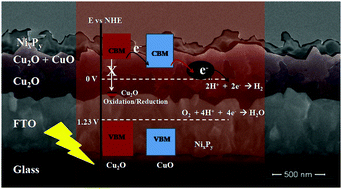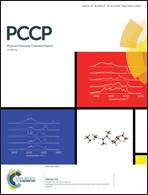Photoelectrochemical hydrogen generation employing a Cu2O-based photocathode with improved stability and activity by using NixPy as the cocatalyst†
Abstract
With the tactical integration of band edge energetics concepts in semiconducting films to reduce charge recombination and photocorrosion, an improvement in the photocurrent can be achieved by introducing CuO and NixPy into Cu2O films. Photodegradation limitations of Cu2O are overcome by the Cu2O–CuO–NixPy photocathode. NixPy, because of its excellent electrocatalytic hydrogen evolution activity, helps in obtaining better stability and activity. The individual effects of CuO and NixPy have been investigated and it is found that the activity enhancement stems mainly from the contribution of NixPy, whereas CuO helps with the unidirectional flow of photogenerated charges to prevent the photocorrosion of Cu2O. Relative to bare and modified Cu2O, Cu2O–CuO–NixPy shows a considerable reduction in the overpotential and a remarkable improvement in the photocurrent at 0 V (vs. RHE). This is the first report on the use of NixPy as the co-catalyst in a Cu2O based photocathode system to improve its photostability as well as its activity.



 Please wait while we load your content...
Please wait while we load your content...